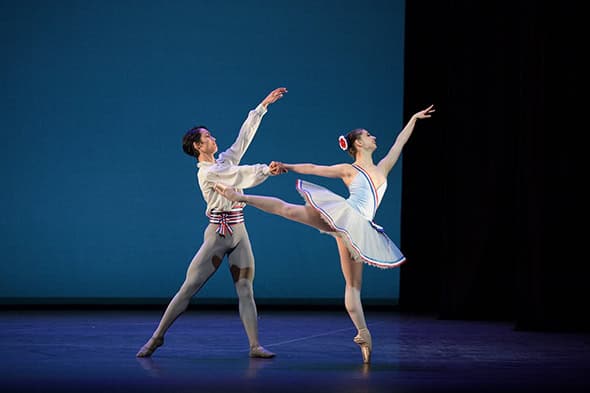Curated by Carlos, Birmingham Royal Ballet at Sadler’s Wells
Posted: December 4th, 2021 | Author: Nicholas Minns & Caterina Albano | Filed under: Performance | Tags: Alessandra Ferri, April Dalton, Birmingham Royal Ballet, Carlos Acosta, Daniela Cardim, Eilis Small, Giulia Scrimieri, Goyo Montero, Lou Cope, Madeleine Kludje, Miguel Altunaga, Paul Englishby, Pina Bausch | Comments Off on Curated by Carlos, Birmingham Royal Ballet at Sadler’s WellsCurated by Carlos, Birmingham Royal Ballet, Sadler’s Wells, November 4

The Birmingham Royal Ballet program at Sadler’s Wells is titled Curated by Carlos, a branding that links the identity of the company to the personality and reputation of its new artistic director, Carlos Acosta. One of the selling points of the program is a ‘new duet’ with Acosta and Alessandra Ferri, but the solipsistic branding and the promotional focus on Ferri hardly constitute Acosta’s unqualified confidence in the image of the company he now leads. Uncannily, the effect of the three works he has curated, by Spanish and Latino choreographers, also serves to downplay the individuality of his dancers and promotes instead a uniformity that effaces them.
The company metamorphosed from the Sadler’s Wells Royal Ballet, settling in Birmingham in 1990, a city with a burgeoning cultural life that already counted Simon Rattle and the Birmingham Symphony Orchestra as one of its calling cards. The term ‘levelling up’ had not been invented at the time but BRB’s change of home was part of a politically favoured redistribution of cultural assets. As an art form, ballet is independent of its home city, but the company’s presence and achievements bring the city reflected pride and prestige in the way the late Pina Bausch gave the industrial city of Wuppertal an international reputation. Acosta has brokered a more direct relationship with Birmingham by offering a dutiful gesture of appreciation to the city in the first work on his triple bill, City of a Thousand Trades co-directed by choreographer Miguel Altunaga and dramaturg Madeleine Kludje, currently the associate director of Birmingham Repertory Theatre. Its title is taken from a nineteenth century description of the city at a time when immigration and industry spurred its enormous growth. The multinational cast of BRB already acts as a proxy for immigration, but Giulia Scrimieri’s set focuses uniquely on construction as the representative industry; scaffolding poles and wheeled wooden forms become the city’s leitmotif, handled throughout with balletic grace. The co-direction effectively divides the work’s focus: Kludje celebrates the value of the city’s individuals shaped by oral histories and recorded poetry by Birmingham Poet Laureate, Casey Bailey, while Altunaga celebrates the city’s homogeneity through the value of a corps de ballet. Mathias Coppens’ score serves both approaches but cannot unite them. City of a Thousand Trades is studious in its reverence but fails to deliver the kind of spontaneous reward for which the city might be remembered.

Daniela Cardim’s Imminent, to a lush but emotionally predictable score by Paul Englishby, starts from an existential questioning about the role of the individual in a society affected by calamitous environmental and political issues. With help from dramaturg Lou Cope, Cardim has extruded these questions into an abstract balletic form with Eilis Small as the individual in a flock of classically trained dancers in tunics for whom the answer to everything is either an arabesque or a pirouette. Only April Dalton’s set — a backdrop of white papier-mâché cliffs inset with an incongruous hinged door — gives any kind of direction to the work: a choice for the dancers of either passing through the open door into the mysterious light of the unknown or remaining in the comfort of unknowing. Some do, some don’t. It’s all a bit banal and underwhelming, questioning less the role of the individual conscience in society than the relationship between choreographer and dramaturg.

Goyo Montero’s Chacona is evidently designed to be the ballast that will anchor the entire program. Choreographed to a full-blooded transcription by Ferruccio Busoni of Bach’s Chorale Prelude No. 3 and to three instrumental interpretations of the chaconne from Bach’s Partita No.2 in D Minor, Montero’s opening geometric corridor of dark-clad bodies sculpted in light has the brooding suggestion of a clandestine obsession. Imposed on the rectangular geometry of the dancers is a triangle with musicians at each apex: pianist Jonathan Higgins and a Steinway grand at the back with Robert Gibbs on violin and Tom Ellis on classical guitar on either side. Into this muscular environment Montero introduces the lithe Alessandra Ferri for a brief appearance with Acosta as her partner but they have no influence on the complex choreographic monolith that engulfs them; Ferri’s appearance and artistry are subsumed into the shadowy darkness of the stage. No sooner do they appear than we start to wonder where she and Acosta have gone; this is the reality of the much-hyped duet, a short interpolation that Montero has deftly concealed within his original construction. While it leaves the choreography intact the company recedes into its oppressive, sometimes brutal embrace.
